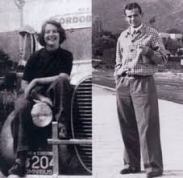
Alfredo De Angelis generally has a bad reputation among international tango dancers, even though I know some who actually love him to death, especially the highly dramatic tracks from the 1950s with Oscar Larroca, for example. I do think this reputation is justified to a large extent, because De Angelis intentionally created a kind of accessible, simple, “popular” music that dancers nowadays usually refer to as “kitsch”. A case in point is that also in Argentina his music was often called ”merry-go-round music” due to its unpretentious nature, and an Argentine once told me that it also once literally was merry-go-round music played in… well, merry-go-rounds.
However, as an “ambassador” of tango’s Golden Age (1935 to approximately 1945), I do appreciate some of his early music quite a bit, especially while he had an amazing singer on board, Floreal Ruiz, who left to join Troilo instead. I enjoy sometimes playing De Angelis with Ruiz as a DJ early on in a milonga and I also, every once in a while, experiment with some of the other early repertoire as well. “But why, Lucas, are you crazy? I am Theresa Faus and I refuse to even play the most famous 1940s valses because of because! This is outrageous!“ Well, because I think that this early period has a beautiful, romantic, warm quality to it that I find in no other orchestra, and if you can carefully pick a few decent songs, you can actually see that (opinion alert!) this orchestra probably had more promise and potential than it ultimately delivered… which I feel is not only true for De Angelis but for many orchestras that simply fell dramatically in quality after the Golden Age boom started to break down.
So, even though also a lot of the early material is not really to my taste, and frankly even annoying, my point is that the romantic idea of the orchestra’s sound can sometimes lead to a few pretty songs, and one of them definitely is Pregonera, which is actually also a composition by De Angelis himself. I love the lyrics of this song, especially the last and unsung part that I’ve naturally included in my translation below. And even though the music is, well, quite a bit kitschy, it simply works really well and creates a beautiful, romantic and nostalgic setting. The funny thing to me here is that, this being a composition by De Angelis himself, his often-criticized style (like the really high violins) are so ingrained in the music that even the recordings by other orchestras suddenly sound suspiciously Deangelisely.
Speaking of which, I will also upload a video for my favorite version (!!!) which is totally secret until further notice. Actually, I am such a nerd that I think my “Whatsapp Status” (otherwise I’d never even bother having one) has been two lines from the third part of the lyric for about two years now. That is quite some dedication to something that has an awful lot to do (albeit indirectly) with De Angelis, but as I always say, it’s never to late to come out of the closet! Which is even more poignant considering that I am not particularly known for being an admirer of this orchestra. I guess hypocrisy is my middle name, ”blah blah kitsch blah blah Larroca blah blah” but how about another nice song?
Pregonera (Flower Seller)
Lyrics: José Rótulo
Composition: Alfredo de Angelis
Princesita rubia de marfil
dueña de mi sueño juvenil,
la que pregonando flores
un día de abril,
recuerdo por las calles de París.
“Una rosa roja para usted,
roja como el ansia de querer,
rosas y claveles blancos,
blancos de ilusión”
y sigue la princesa su pregón.
Blonde princess of alabaster skin,
mistress of my youthful dreams…
she whom I remember, one April day,
selling flowers on the streets of Paris.
“A red rose for you,
red like the desire to love…
roses and white carnations,
white like a dream of hope…”
and so my princess, calling out, passes by.
“Un cariño y un clavel
para el ojal, para el querer.”
El clavel es de ilusión,
mi corazón rojo punzó.
Ay, la tarde va muriendo,
y el pregón me va siguiendo.
“Un cariñito y un clavel”
sólo el clavel, lo que quedó.
“A caress and a carnation,
for your jacket, for love.”
A carnation for hope,
for my yearning heart.
And as the evening fades,
her cry still follows me.
“A caress and a carnation!”
now, only the carnation remains.
(Princesita rubia de marfil,
dónde fue tu risa tan sutil,
junto con tus flores muertas
muere mi ilusión.
Y escucho el eco tenue de tu voz.
Es como un susurro sin cesar,
que va despertando mi ansiedad,
es mi fantasía loca
que vuelve a soñar.
De nuevo soy feliz con tu cantar.
Blonde princess of alabaster skin,
what has become of your subtle laugh?
Along with your dead flowers
my hope dies too.
But as I hear the faint echo of your voice,
like a ceaseless whisper,
it awakens a feeble hope.
It’s my infatuation…
making me dream again.
Your song… making me happy again.)




sylviesims124
/ July 29, 2022So wonderful to have the lyrics line by line as it is being sung.
Thank you .
Ellen Mashkovich
/ July 29, 2022Admire your work! I can say De Angelis music loves me ! But not La Rocca one.. the other
Dante with Martel. Very romantic danceble and sentimental. Thank you!!!
BEATRIZ DUJOVNE
/ July 30, 2022Regardless of what has been said about De Angelis Orquesta, I witnessed at my home in Buenos Aires (where I was born), my father’s passion for this Orquesta which played live on Radio EL MUNDO between 8 and 8:30 pm.